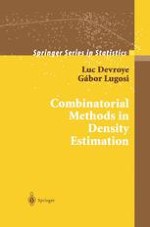
2001 | OriginalPaper | Chapter
Introduction
Authors : Luc Devroye, Gábor Lugosi
Published in: Combinatorial Methods in Density Estimation
Publisher: Springer New York
Included in: Professional Book Archive
Activate our intelligent search to find suitable subject content or patents.
Select sections of text to find matching patents with Artificial Intelligence. powered by
Select sections of text to find additional relevant content using AI-assisted search. powered by
A random variable X on Rd has a density f if, for all Borel sets A of Rd, ∫ A f(x)dx = P{X ∈ A}. It thus serves as a tool for computing probabilities of sets. As it is a function that reveals the local concentration of probability mass, it may be used to visualize distributions of random variables. The statistician’s problem, then, is to estimate f from an i.i.d. sample X1,…,X n drawn from f. A density estimate is simply a mapping f n : Rd × (Rd)n → Rd (we write f n (x; X1,…,X n ) or f n (x)). It is the global closeness of f n to f that interests us. The choice of a density estimate is governed by a number of factors, like consistency, smoothness, ease of computation, interpretability, flexibility, robustness, versatility, and optimality for certain criteria. The early work in the field approached the problem largely as a functional estimation problem: f was treated as any function, and tools from function approximation theory came to the rescue in the analysis of the performance of density estimates—Taylor series expansions played a key role, for example. The view we take in nonparametric density estimation is that f is largely unknown and that no assumptions can be made about its properties. Methods or properties that are valid for all densities are said to be universal. It is quite surprising that there are density estimates that can approximate any density f asymptotically in an appropriate sense. Simple histogram and kernel estimates have this property for example. But when people started studying rates of convergence, or error bounds for particular n, they invariably had to place conditions on the smoothness or boundedness of f. This was frustrating , because it was nearly impossible to test whether these assumptions were satisfied. Just try cooking up a test that decides whether the essestial supremum of f is bounded, for example!